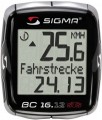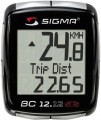The presence of backlight in the display of the bike computer.
This feature allows the rider to see the display in any light, even in total darkness.
A backlit cycle computer is the best option for those who plan to ride frequently after sunset. However this function additionally consumes battery power; but in most models, the backlight turns on only when a special button is pressed, and you can see the display in just a couple of seconds.
—
Slot for memory cards. Slot for removable memory cards, most often in microSD size (specific supported varieties may be different, they should be specified separately). Such maps not only expand the built-in memory of the bike computer, but can also be used to exchange data with other devices: for example, using such a carrier, you can upload GPS trip tracks to a laptop or download navigation maps from the same laptop. This feature is found mainly in advanced models.
—
Impact protection. The presence in the device of enhanced protection against shocks and concussions; in some models, increased resistance to vibrations is also claimed. It is worth noting here that any bike computer is made with the expectation of shaking and jolts that inevitably occur when riding a bike. Therefore, shock protection usually means increased durability, allowing you to endure not only standard road shaking, but also extreme use like downhill or cyclocross. At the same time, it would not hurt to clarify the specific degree of such protection separately.
—
Connecting to a smartphone. The ability to connect the cycle computer to a smartphone — usually via Bluetooth (see "Sensors"). Theoretically, it is possible to connect with other gadgets, but the smartphone, unlike them, can be used on the go (mounted on the steering wheel or just kept with you). Connecting to a smartph
...one can include many different functions, their set should be specified separately. One of the most popular options is “live broadcast” of data from a bike computer to a fitness application on a smartphone, or even to special social Internet services for training.
— Connecting to a PC. The ability to connect the bike computer to a PC or laptop. The classic way to use this feature is to download the data collected by the bike computer to a PC for further processing. Note that the connection itself can be carried out in different ways: some models use a simple USB cable (usually included in the kit), others use a wireless adapter that must be purchased separately.
— Mount on the hand. The ability to mount the bike computer on the user's hand. This feature is found exclusively in wireless models (see "Type"); usually, a special strap is used for this, purchased separately. For some users, this mount is more convenient, and in extreme driving it can be even more reliable than a standard handlebar mount.
— Calculation of calories. The function of calculating the calories expended by the user. Note that devices with this feature do not measure actual energy consumption — they calculate the number of calories burned based on speed, distance, altitude difference, heart rate, etc. The result is approximate, but perfect accuracy is not required in this case.
— Building a route. A feature that is found exclusively in models with a GPS module (see "Sensors"). Usually, it involves connecting to a PC and building a route on the map in a special application, after which this data is loaded into the bike computer — and the user can follow the route, receiving hints about directions from the device screen. And after the trip, you can upload the actual route with the results of the race. Some models with this feature even have integration with “social” sports services that allow you to share routes and compete with other users.
— Automatic start-stop. Function of automatic start and stop of measurements. Models with this function turn on at the start of movement, when the speed sensor gives the first signal, and turn off (stop recording parameters) some time after stopping. This saves the user from having to turn on/off the cycle computer manually.
— Clock. The presence in the cycle computer of its own clock. This means not just a time counter that allows you to record the time of the trip, but a full-fledged watch that displays the current time of day. In addition to general convenience (the ability to find out what time it is at any time), this function has more specific applications: for example, the clock tracks the change of day when counting the daily distance traveled (see "Indications").
— Timer and stopwatch. Opportunity of work of the bicycle computer in the mode of the timer and a stop watch; usually both of these possibilities are provided, so they are combined in this case. These functions differ from travel time readings (see "Indications") in that the countdown can be started and stopped at the user's command — usually by pressing a button. A stopwatch can be useful, in particular, for measuring the total travel time, taking into account all stops; timer — for counting a specific training time.
— Battery level. An indicator showing the current battery level. It can have a different appearance and specifics of use: for example, in some models, the charge indicator is displayed on the screen at the user's command, in others it is displayed constantly, usually in the upper part. The indicator readings are quite approximate, but it still makes it much easier to monitor the state of the battery and reduces the risk of running out of charge at the most inopportune moment.
— Non- volatile memory. The presence of non-volatile memory in the cycle computer. Various information, especially measurement data, is stored in such a memory even during power outages — for example, when removing the battery or discharging the battery to zero.
— Fuel economy statistics. "Ecological" function, designed mainly for those who are worried about the preservation of the environment. Allows you to estimate how much fuel the user saved by riding a certain distance on a bicycle instead of using a car. However, environmental awareness is not limited to: data on fuel economy can be a powerful motivation from a financial point of view.
